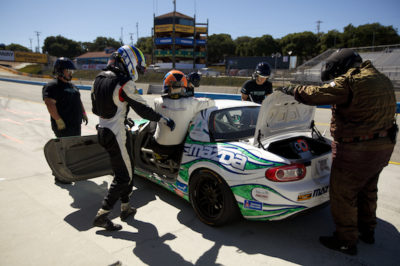“As soon as he stops, I punch him and yank him out of the car.”
Pierre Kleinubing is laughing about the idea of doing a driver change with Jayson Clunie in the No. 31 Street Tuner i-Moto Mazdaspeed3 that way during a Continental Tire Series race, but he doesn’t really mean it. It’s actually a carefully choreographed routine to make sure that driver changes happen well before the rest of the pit service is done. For drivers who don’t regularly do driver changes, though – including many who will be racing in the N.A.S.A. USAF 25 Hours of Thunderhill on Dec. 7-8 – it can be one of the challenges of endurance racing.
“He gets out of the car, I get in, I buckle two of my belts, he hands me the third and the window net goes up,” he explains – seriously, this time. “At that point, we’re hopefully done way ahead of the fuel, so we have a little bit of time to button everything up, get the radio working, reset the fuel and off we go. We can do it usually under 23 seconds; the fuel takes 30 or so.”
When they started driving together, Kleinubing and Clunie practiced their driver changes. Now they only do it every once in a while – both say that doing it too much would only confuse things.
“I really find that we know what we’re doing now,” says Clunie. “To keep hammering at it and hammering at it, I think is detrimental. If we run into something that pops up that becomes an issue, then I think we would practice to make sure that issue doesn’t happen again. But we’ve been fortunate so far that we’ve had good driver changes.”
Not every driver change goes smoothly, of course. When something does go awry, the key is to stay calm.
“You just try to let your instinct do it, and if something goes a little bit wrong, you don’t panic over it,” says Clunie. “You just continue to do your job. If you overthink and something goes wrong and you’re too panicked, then everything just starts to fall down.”
“Don’t try to rush anything, because it will be worse,” echoes Kleinubing. “We know what we need to do.”


 ACCESSIBILITY
ACCESSIBILITY